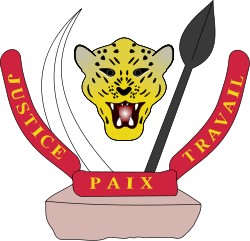Democratic Republic of the Congo presidential election, 1970
 |
| This article is part of a series on the politics and government of the Democratic Republic of the Congo |
|
Government |
|
Judiciary |
| Foreign relations |
| United Nations Mission |
A presidential election was held in the Democratic Republic of the Congo on 1 November 1970. The only candidate was Joseph Mobutu, who had taken power in a military coup five years earlier. The election took the format of a "yes" or "no" vote for Mobutu's candidacy, with the results showing he won more "yes" votes than the number of registered voters, even though voting was not compulsory.[1]
Background
Following the promulgation of a new constitution after a referendum in 1964, general elections were held in the newly renamed Democratic Republic of the Congo in March and April in 1965. The elections were won by the Congolese National Convention, led by former secessionist leader Moise Tshombe, which took 122 of the 177 seats. However, President Joseph Kasa-Vubu later dismissed Tshombe and appointed Évariste Kimba of the Congolese Democratic Front Prime Minister instead. In a vote in parliament on 14 November, Kimba failed to have his government approved.[2] However, Kasa-Vubu reappointed him as Prime Minister the following day. Ten days later Mobutu led a military coup and installed himself as President, banning political parties.
On 20 May 1967 Mobutu formed the Popular Movement of the Revolution . In June 1967 a new constitution was drawn up, establishing a unitary state with a strong executive presidential system and unicameral parliament. It also limited the number of political parties to two, and enfranchised women.[1] It was approved by a referendum in which 97.8% of voters voted for it.[3]
Following a census in early 1970, presidential elections were organised for 1 November. The date was set so that Mobutu would have passed his fortieth birthday by the time the elections occurred, as the constitution stated that candidates must be at least forty years old.[1]
Results
While the constitution allowed for the existence of a second party, the MPR was the only party allowed to nominate candidates. As a result, Mobutu appeared alone on the presidential ballot. Voters had the choice of a green ballot paper representing a "yes" vote, or a red paper, representing a "no" vote. Voting was not secret,[1] and the number of votes cast (10,131,826) was over 30,000 more than the number of registered voters (10,101,330).[4]
| Candidate | Party | Votes | % |
|---|---|---|---|
| Joseph Mobutu | Popular Movement of the Revolution | 10,131,669 | 100 |
| Against | 157 | – | |
| Total | 10,131,826 | 100 | |
| Registered voters/turnout | 10,101,330 | 100.3 | |
| Source: Nohlen et al. | |||
Aftermath
Parliamentary elections were held on 15 November in a similar fashion, with the official candidates being approved by over 99% of the voters.[1] Soon afterward, the MPR was formally declared to be the only legal party in the country, though the Congo had effectively been a one-party state since the MPR's formation.[5][6]
The country was renamed Zaire the following year, and Mobutu changed his own name to Mobutu Sese Seko in 1972. He continued to rule the country until being overthrown in 1997.
References
- 1 2 3 4 5 DRC: Elections under the Second Republic EISA
- ↑ DRC: Constitutional Crisis between Kasavubu and Tshombe EISA
- ↑ Elections in Congo-Kinshasa African Elections Database
- ↑ Nohlen, D, Krennerich, M & Thibaut, B (1999) Elections in Africa: A data handbook, p294 ISBN 0-19-829645-2
- ↑ Kaplan, Irving (ed.). Zaire: A Country Study. Third Edition, First Printing. 1979.
- ↑ Law 70-001 of December 23, 1970 amended the text of article 4 of the constitution as follows: "The Popular Movement of the Revolution is the only political party in the Republic" (Le Mouvement populaire de la révolution est le seul parti politique de la République.).